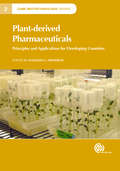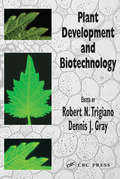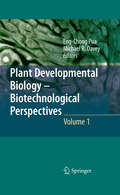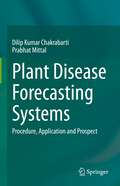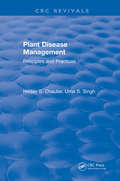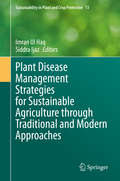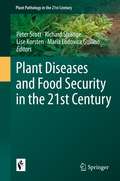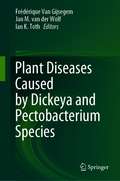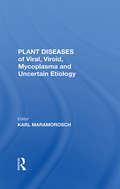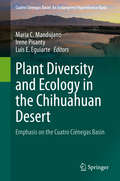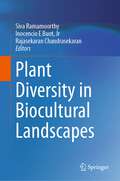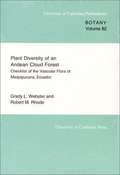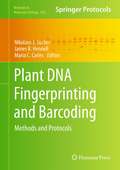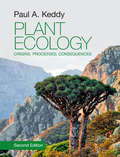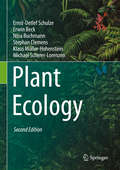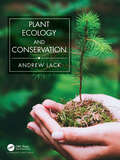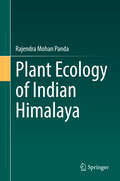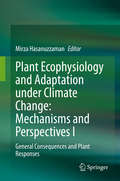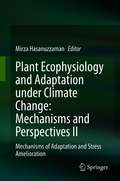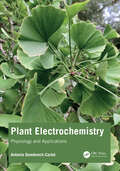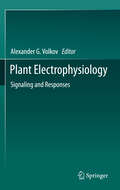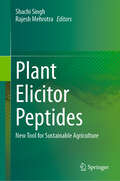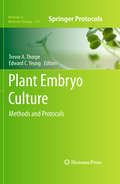- Table View
- List View
Plant-derived Pharmaceuticals: Principles and Applications for Developing Countries (CABI Biotechnology Series #2)
by Rima Menassa Karen McDonald Shawn Chen Inga Hitzeroth Gregory Pogue Pascal Drake Andreas Günter Lössl M A D'Aoust David Aviezer Elizabeth Loza Rubio John Howard Carla Marusic Somen NandiDescribing recent developments in the engineering and generation of plants as production platforms for biopharmaceuticals, this book includes both vaccines and monoclonal antibodies. It has a particular emphasis on targeting diseases which predominate in less developed countries, encompassing the current state of technologies and describing expression systems and applications. This book also includes a variety of vaccine case studies, protecting against pervasive infectious diseases such as rabies, influenza and HIV.
Plant Desiccation Tolerance
by Ulrich Lüttge Erwin Beck Dorothea BartelsDesiccation tolerance was essential when plants first began to conquer land, roughly 400 million years ago. While most desiccation-tolerant plants belong to basal phylogenetic taxa, this capacity has also evolved among some vascular plant species. In this volume renowned experts treat plant desiccation tolerance at the organismic as well as at the cellular level. The diversity of ecophysiological adaptations and acclimations of cyanobacteria, eukaryotic algae, mosses, and lichens is addressed in several chapters. The particular problems of vascular plants during dehydration/rehydration cycles resulting not only from their hydraulic architectures, but also from severe secondary stresses associated with the desiccated state are discussed. Based on the treatment of desiccation tolerance at the organismic level, a second section of the book is devoted to the cell biological level. It delineates the general concepts of functional genomics, epigenetics, genetics, molecular biology and the sensing and signalling networks of systems biology involved in dehydration/rehydration cycles. This book provides an invaluable compilation of current knowledge, which is a prerequisite for a better understanding of plant desiccation tolerance in natural as well as agro- and forest ecosystems where water is one of the most essential resources.
Plant Development and Biotechnology
by Robert N. Trigiano Dennis J. GrayBiotechnology revolutionized traditional plant breeding programs. This rapid change produced new discussions on techniques and opportunities for commerce, as well as a fear of the unknown. Plant Development and Biotechnology addresses the major issues of the field, with chapters on broad topics written by specialists. The book applies an informal s
Plant Developmental Biology
by Lars Hennig Claudia KöhlerThe beauty and variety of plants has fascinated mankind for thousands of years, and this fascination continues today as plant developmental biologists discover mechanisms that control the establishment of specialized cell types, tissues, and organs from the fertilized egg during a plant's life. In Plant Developmental Biology: Methods and Protocols, expert researchers provide a collection of protocols for many of the common experimental approaches in plant developmental biology, including diverse methods that range from grafting over bimolecular fluorescence complementation to chromatin immunoprecipitation. Chapters are divided into six major parts: growth protocols, manipulation of gene activity, assaying developmental phenotypes, assaying gene activity, testing protein-protein interactions, and probing chromatin. Composed in the highly successful Methods in Molecular BiologyTM series format, each chapter contains a brief introduction, step-by-step methods, a list of necessary materials, and a Notes section which shares tips on troubleshooting and avoiding known pitfalls. Comprehensive and revolutionary, Plant Developmental Biology: Methods and Protocols is an essential guide for all plant developmental geneticists, biochemists, and researchers in stress physiology and plant nutrition.
Plant Developmental Biology - Biotechnological Perspectives
by Michael R. Davey Eng Chong PuaUnderstanding the mechanisms whereby plant development is regulated is crucial for crop improvement using genetic engineering. This work, comprising two volumes, reviews recent advances in plant developmental biology and explores the possibility of their biotechnological applications. Volume 2 focuses on development-related areas, including tissue culture (somatic and microspore embryogenesis, somaclonal variation), plant processes (photosynthesis, seed maturation and seed proteins, fatty acids, vitamins, alkaloids, flower pigments and scent), signalling (amino compound-containing lipids, auxins, cytokinins and light), and molecular genetics of developmental regulation (RNA silencing, DNA methylation, epigenetics, activation tagging, homologous recombination and synthetic promoter engineering). This work is a key reference for plant breeders, researchers and graduate students in the fields of plant biotechnology, agronomy, horticulture, genetics and functional genomics, and cell and molecular biology.
Plant Disease Forecasting Systems: Procedure, Application and Prospect
by Dilip Kumar Chakrabarti Prabhat MittalThis book focus on creating popularity and interest in modeling, derivation of equations for plant disease forecasting or construction and use of Web-based Expert Systems among plant pathologists. This book covers descriptions of many historic plant disease epidemics, various forecasting systems and methods of their construction, instruments required for study of plant disease epidemics, widely used commercial forecasting systems and present global scenario of forecasting.In the human history plant disease epidemics have brought unsurmountable misery many a times. Still breaking out of epidemic in any time in any part of the world is a stark reality. The panic spraying of chemical pesticides is not a panacea. Only the IPM technology may give relief. This technology if backed by the disease forewarning system may yield the desired results. Hence, an in depth understanding of plant disease forecasting system and its successful implementation may bring the global food security. This title provides a useful background for all students, practitioners, and researchers interested in the field of epidemiology, food security and agriculture sciences.
Plant Disease Management: Principles and Practices
by Hriday ChaubeThis book attempts to provide to provide concise, critical, synthetic and up-to-date coverage of different aspects of plant disease management. The first eleven chapters are devoted to principles and related aspects and the remining seven to management practices based on them. The book attempts to capture some of the images of such rapidly expanding fields as host-parasite recognition and biotechnology even at the risk of making the subject a bit conceptual. This book is intended to serve as a text for advanced undergraduate and graduate students of plant pathology and related disciplines and as a reference source for teachers, researchers, students, and technologists.
Plant Disease Management Strategies for Sustainable Agriculture through Traditional and Modern Approaches (Sustainability in Plant and Crop Protection #13)
by Imran Ul Haq Siddra IjazThis book provides an account of the classical and recent trends in plant sciences, which have contributed for disease management strategies in plants for sustainable agriculture. Advancements in the disciplines of biological sciences like biotechnology, microbiology, bioinformatics as well as information and communication technology etc has given the new dimensions for the development of new plant disease management strategies. By keeping this perspective in view, the editors collected and compiled the useful, practical and recent information regarding plant disease management from a diverse group of authors from different countries associated with well-reputed scientific, teaching and research organizations with the objective to update and equip the researchers with comprehensive and latest knowledge of plant disease management. This book is based on the knowledge of traditional and modern approaches for plant disease management. It has 15 chapters, each chapter describing the pillar strategies, which may be the possible way for crop protection from diseases.This effort deals with the history and recent trends in plant disease control, plant genetics and physiology in disease prognosis, conventional plant breeding program for disease resistance, synthetic chemicals: major component of plant disease management, biological antagonism: expected safe and sustainable way to manage plant diseases , soil microbes and plant health, conventional and modern technologies for the management of post-harvest diseases, nanobiotechnology, an innovative plant disease management approach, transgenic approaches in plants: strategic control for disease management, exploiting RNAi mechanism in plants for disease resistance, genome editing technologies for resistance against phytopathogens: principles, applications and future prospects, plant health clinics in Pakistan: operations and prospects, precision agriculture technologies for management of plant disease, quarantine and regulations and development and implementation of IDM program for annual and perennial crops.
Plant Diseases and Food Security in the 21st Century (Plant Pathology in the 21st Century #10)
by Peter Scott Richard Strange Lise Korsten Maria Lodovica GullinoOf the global population of more than 7 billion people, some 800 million do not have enough to eat today. By 2050, the population is expected to exceed 9 billion. It has been estimated that some 15% of food production is lost to plant diseases; in developing countries losses may be much higher. Historically, plant diseases have had catastrophic impact on food production. For example: potato blight caused the Irish famine in 1845; brown spot of rice caused the Great Bengal Famine of 1943; southern corn leaf blight caused a devastating epidemic on the US corn crop in 1970. Food security is threatened by an ongoing sequence of plant diseases, some persistent for decades or centuries, others more opportunistic. Wheat blast and banana xanthomonas wilt are two contrasting examples of many that currently threaten food production. Other emerging diseases will follow. The proposed title aims to provide a synthesis of expert knowledge to address this central challenge to food security for the 21st century. Chapters [5] and [11] are available open access under a Creative Commons Attribution 4.0 International License via link.springer.com.
Plant Diseases Caused by Dickeya and Pectobacterium Species
by Frédérique Van Gijsegem Jan M. van der Wolf Ian K. TothThis book provides a detailed review of many different aspects of pathogens, from the effects of single base pair mutations to large-scale control options, bringing into a single volume over 100 years of findings from thousands of researchers worldwide. Diseases caused by soft rot Pectobacteriaceae (SRP) are a major cause of loss to crop, vegetables and ornamental plants worldwide, and have been found on all continents except Antarctica. While different aspects of the SRP have appeared in other books on plant disease, no book, until now, has been dedicated solely to them.
Plant Diseases Of Viral, Viroid, Mycoplasma And Uncertain Etiology
by Karl MaramoroschThe adverse impact of plant diseases is felt around the world. In this book, the contributors analyze the nature and origins of pathogens that affect some economically important food and fiber crops.
Plant Diversity and Ecology in the Chihuahuan Desert: Emphasis on the Cuatro Ciénegas Basin (Cuatro Ciénegas Basin: An Endangered Hyperdiverse Oasis)
by Maria C. Mandujano Irene Pisanty Luis E. EguiarteEnvironmental and specific diversity in the Chihuahuan desert in general, and in the Cuatro Ciénegas Basin in particular, has long been recognized as outstanding. This book provides a global ecological overview, together with in-depth studies of specific processes. The Chihuahuan desert is the warmest in North America, and has a complex geologic, climatic and biogeographical history, which affects today’s distribution of vegetation and plants and generates complex phylogeographic patterns. The high number of endemic species reflects this complex set of traits. The modern distribution of environments, including aquatic and subaquatic systems, riparian environments, gypsum dunes and gypsum-rich soils, low levels of phosphorous and organic matter, and high salinity combined with an extreme climate call for a range of adaptations. Plants are distributed in a patchy pattern based on punctual variations, and many of them respond to different resources and conditions with considerable morphological plasticity. In terms of physiological, morphological and ecological variability, cacti were identified as the most important group in specific environments like bajadas, characterized by high diversity values, while gypsophytes and gypsovagues of different phylogenies, including species with restricted distribution and endemics.
Plant Diversity in Biocultural Landscapes
by Siva Ramamoorthy Inocencio E Buot Rajasekaran ChandrasekaranThe edited book highlights comprehensive studies on plant diversity dynamics, ecosystem processes, and best conservation practices from the interdisciplinary perspectives such as the botanists, ecologists, conservation biologists, geneticists, cell biologists, molecular biotechnologists, and social scientists. The main focus of the book is to address biodiversity loss and ecosystem collapse amidst the escalating climate change problems, aggravated by anthropogenic activities in biocultural landscapes. The book describes the biocultural landscape of today, ecology of plant diversity, botany of keystone and other rare species of economic and pharmaceutical significance, ecosystem processes, conservation, and emerging frameworks to sustain biocultural landscapes in the Anthropocene. Biocultural landscapes are tracks of land in many parts of the world, shaped by unique human-nature interactions. Many of these landscapes are populated with indigenous peoples with a unique way of life including their interaction with plants and the environment. The relationship between humans and nature in biocultural landscapes used to be harmonious. However, as the human population surges, much pressure has been experienced by the landscape, hence, the loss of biodiversity and degradation of ecosystem services that cascade to agricultural systems. The book is of interest to teachers, professors, policymakers, researchers, and advocates in the fields of botany, ecology, taxonomy, biodiversity conservation, environmental science, molecular biology and genomics, molecular ecology, agriculture, and Agri-tourism, forestry, social science, and climate change professionals. Also, the book serves as a good reference and additional reading material for undergraduate and graduate students.
Plant Diversity of an Andean Cloud Forest: Inventory of the Vascular Flora of Maquipucuna, Ecuador
by Grady L. Webster Robert M. RhodeBased on work spanning a decade, this study of the Maquipucuna area on the western slopes of the Andes discusses the climate, vegetation, ecological relationships, and flora, and emphasizes the importance of the Maquipucuna area as a biological reserve. In addition to the checklist of the flora, which enumerates 1,650 species (including 228 species of pteridophytes and over 200 species of orchids), appendices give information on floristic composition of communities, distribution of epiphytes, and elevational ranges of families and genera. The illustrations include a map, landscapes, and characteristic species.
Plant DNA Fingerprinting and Barcoding
by Maria C. Carles James R. Hennell Nikolaus J. SucherMolecular cloning and DNA-based analysis have become part of every molecular life science laboratory. The rapid adoption of DNA-based techniques has been facilitated by the introduction of the polymerase chain reaction (PCR), which has made cloning and characterization of DNA quick and relatively simple. PCR is virtually part of every variation of the plethora of approaches used for DNA fingerprinting today. Plant DNA Fingerprinting: Methods and Protocols aims to bring together the different currently available genome-based techniques into one repository. This volume contains detailed protocols for the preparation of plant genomic DNA, fingerprinting of plants for the detection of intra-species variations, the use of DNA barcoding, as well as methods for the bioinformatic analysis of data. Also included are several discussions on the broader issues of genome-based approaches in order to provide a sound understanding of the principles of these methods. Written in the successful Methods in Molecular BiologyTM series format, chapters include introductions to their respective topics, lists of the necessary materials and reagents, step-by-step, readily reproducible protocols, and notes on troubleshooting and avoiding known pitfalls. Authoritative and easily accessible, Plant DNA Fingerprinting: Methods and Protocols is tailored principally for those who seek to augment their current methods of plant analysis and quality control using genome-based approaches as well as for scientists and researchers in different plant sciences.
Plant Ecology
by Keddy Paul A.Presenting a global and interdisciplinary approach to plant ecology, this much-awaited new edition of the book Plants and Vegetation integrates classical themes with the latest ideas, models, and data. Keddy draws on extensive teaching experience to bring the field to life, guiding students through essential concepts with numerous real-world examples and full-colour illustrations throughout. The chapters begin by presenting the wider picture of the origin of plants and their impact on the Earth, before exploring the search for global patterns in plants and vegetation. Chapters on resources, stress, competition, herbivory, and mutualism explore causation, and a concluding chapter on conservation addresses the concern that one-third of all plant species are at risk of extinction. The scope of this edition is broadened further by a new chapter on population ecology, along with extensive examples including South African deserts, the Guyana Highlands of South America, Himalayan forests and arctic alpine environments.
Plant Ecology
by Ernst-Detlef Schulze Erwin Beck Nina Buchmann Stephan Clemens Klaus Müller-Hohenstein Michael Scherer-LorenzenThis completely updated and revised second edition provides a unique and up-to-date treatment of all aspects of plant ecology, making it an ideal textbook and reference work for students, researchers and practitioners. More than 500 high-quality images and drawings, mostly in colour, aid readers’ understanding of various key topics, while the clear structure and straightforward style make it user friendly and particularly useful for students. Written by leading experts, it offers authoritative information, including relevant references. While Plant Ecology primarily addresses graduate students in biology and ecology, it is also a valuable resource for post-graduate students and researchers in botany, environmental sciences and landscape ecology, as well as all those whose study or work touches on agriculture, forestry, land use, and landscape management. Key Topics: - Molecular ecophysiology (molecular stress physiology: light, temperature, oxygen deficiency, water deficit (drought), unfavorable soil mineral conditions, biotic stress) - Physiological and biophysical plant ecology (ecophysiology of plants: thermal balance, water, nutrient, carbon relations) - Ecosystem ecology (characteristics of ecosystems, approaches how to study and how to model terrestrial ecosystems, biogeochemical fluxes in terrestrial ecosystems) - Community ecology and biological diversity (development of plant communities in time and space, interactions between plants and plant communities with the abiotic and the biotic environment, biodiversity and ecosystem functioning) - Global ecology (global biogeochemical cycles, Dynamic Global Vegetation Models, global change and terrestrial ecosystems)
Plant Ecology and Conservation
by Andrew LackPlant Ecology & Conservation is an introduction to the world of plant ecology. It includes the main areas of current research including ideas about plant populations, nutrition and plant community ecology and has a particular emphasis on the interactions of plants with animals, fungi and microorganisms whose important is being increasingly demonstrated. With the world’s environmental problems having such a high profile, the book focusses on the human impact on the world’s plant species. Conservation of the terrestrial world starts with plants as they form the basis of all ecosystems on land. We can only understand how best to conserve the world’s biodiversity with an understanding of the central role of plant ecology. This theme runs throughout with numerous examples of the disruption of ecosystems by human activity emphasising the connection between plant ecology and conservation. Key Features: Boxes present case studies, important statistics and interesting asides Full-colour photos depict key species and habitats and superb line drawings illustrate many concepts Important data are presented in Tables and Figures throughout Each chapter has Key Concepts and review questions to test a reader’s grasp of the content Key References and Further Reading are given for each chapter to point the reader towards the most important and influential literature Jargon is kept to a minimum and a full Glossary of all technical terms is presented The book is aimed primarily at undergraduate and graduate students in any aspect of ecology or plant science. It should also appeal to anyone interested in how plants function and are concerned about what is needed for the conservation of the world’s ecosystems.
Plant Ecology of Indian Himalaya
by Rajendra Mohan PandaThis book discusses plant invasions and environmental impacts on the Himalayas through a novel procedure, and helps to understand the influences of climate, physiography, soil, and disturbance on plant richness in mountain systems. Assessing invasion risks to mountain space under future climate change scenarios is highly significant for appropriate preparedness, and this book details analytical and modeling techniques to assess the conditions of mountain ecosystem and ecology to better inform our preparation for future environmental challenges. The book presents the state-of-the-art understanding of the species-environment relationships in a global biodiversity hotspot, relatively unexplored areas for the Himalayan life-form richness. The book provides not only the academic but also the professional community and policymakers a review and update on modeling applications for determining interactions of the plant species with the environment of a subtropical mountain ecosystem across a climatic gradient. Currently, there is no book in the market addressing the implementation and applications of modeling in the Himalayan plant and environment continuum, and most of the existing books cover the species richness pattern along the elevation gradient and basic ethnobotanical features of a mountain system. Since the book covers the applications of novel methods and modeling for ecological analysis of mountain ecosystems, it will also be significant for the professional market. Therefore, the book aims to fill the gap between scientists and professionals in the use of modeling strategies to monitor biodiversity in mountain systems for the formulation of conservation, adaptation, and mitigation principles.
Plant Ecophysiology and Adaptation under Climate Change: General Consequences and Plant Responses
by Mirza HasanuzzamanThis book presents the state-of-the-art in plant ecophysiology. With a particular focus on adaptation to a changing environment, it discusses ecophysiology and adaptive mechanisms of plants under climate change. Over the centuries, the incidence of various abiotic stresses such as salinity, drought, extreme temperatures, atmospheric pollution, metal toxicity due to climate change have regularly affected plants and, and some estimates suggest that environmental stresses may reduce the crop yield by up to 70%. This in turn adversely affects the food security. As sessile organisms, plants are frequently exposed to various environmental adversities. As such, both plant physiology and plant ecophysiology begin with the study of responses to the environment. Provides essential insights, this book can be used for courses such as Plant Physiology, Environmental Science, Crop Production and Agricultural Botany.Volume 1 provides up-to-date information on the impact of climate change on plants, the general consequences and plant responses to various environmental stresses.
Plant Ecophysiology and Adaptation under Climate Change: Mechanisms of Adaptation and Stress Amelioration
by Mirza HasanuzzamanThis book presents the state-of-the-art in plant ecophysiology. With a particular focus on adaptation to a changing environment, it discusses ecophysiology and adaptive mechanisms of plants under climate change. Over the centuries, the incidence of various abiotic stresses such as salinity, drought, extreme temperatures, atmospheric pollution, metal toxicity due to climate change have regularly affected plants and, and some estimates suggest that environmental stresses may reduce the crop yield by up to 70%. This in turn adversely affects the food security. As sessile organisms, plants are frequently exposed to various environmental adversities. As such, both plant physiology and plant ecophysiology begin with the study of responses to the environment. Provides essential insights, this book can be used for courses such as Plant Physiology, Environmental Science, Crop Production and Agricultural Botany.Volume 2 provides up-to-date information on the impact of climate change on plants, the general consequences and plant responses to various environmental stresses.
Plant Electrochemistry: Physiology and Applications
by Antonio Doménech-CarbóThe book comprehensively views the intersection between electrochemistry and botany. It attempts to inform people about the capacity of electrochemistry to provide information of interest to plant science. This includes electrophysiology, plant communication, and plant defense responses, as well as chemoecological and phylogenetic aspects. Conversely, the book also treats the capabilities of vegetal systems and vegetal-derived materials to be used in electrochemical applications for sensing, energy production and storage, and environmental issues.
Plant Electrophysiology
by Alexander G. VolkovThis book compiles new findings from the work of internationally renowned experts in plant electrophysiology, biophysics, bioelectrochemistry, ion channels, membrane transport, imaging of water transport, photosynthesis, mechanosensors, osmotic motors, sensing and actuation in plants. First volume covers modern methods in plant electrophysiology and cell electrophysiology. Second volume deals with signal transduction and responses in plants.
Plant Elicitor Peptides: New Tool for Sustainable Agriculture
by Shachi Singh Rajesh MehrotraThis book provides an overview on plant innate immunity triggered by peptide elicitors. It explains how peptide signals provide protection against phytopathogens and can act as an eco-friendly crop protectant. The chapters in the book deal with identification and characterization of plant elicitor peptides and their receptors, understanding the process of defense activation conferred by peptide signals, methods of isolation and application. Various new techniques and future strategies are discussed for utilization of these immunity inducers. Molecular and functional characterization of the elicitors will be useful in the development of elicitation-based technology, including large scale production and commercialization. This book serves as an essential resource for researchers and industries working in the field of physiology and biotic stress management of crop plants.
Plant Embryo Culture
by Trevor A. Thorpe Edward C. YeungA great fascination for biologists, the study of embryo development provides indispensable information concerning the origins of the various forms and structures that make up an organism, and our ever-increasing knowledge gained through the study of plant embryology promises to lead to the development of numerous useful applications. In Plant Embryo Culture: Methods and Protocols, expert researchers from the field provide a ready source of information for culturing zygotic embryos for different types of studies, both theoretical and practical. The book's main sections examine a wide range of related topics, including the culture of zygotic embryos for developmental studies, the application of embryo culture techniques focusing on embryo rescue methods, cryopreservation of zygotic embryos, the use of zygotic embryos as explants for somatic embryogenesis and organogenesis, as well as transformation protocols using zygotic embryos as starting material. Written in the highly successful Methods in Molecular BiologyTM series format, the detailed chapters include introductions to their respective topics, lists of the necessary materials and reagents, step-by-step, readily reproducible laboratory protocols, and vital notes on troubleshooting and avoiding known pitfalls. Authoritative and convenient, Plant Embryo Culture: Methods and Protocols serves as a key reference that can be used by scientists of all backgrounds to help develop their own customized methods for many different species and for a variety of purposes.
